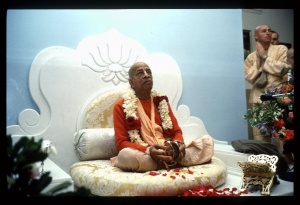CC Adi 13.5 (1975): Difference between revisions
(Vanibot #0027: CCMirror - Mirror CC's 1996 edition to form a basis for 1975) |
(Vanibot #0020: VersionCompareLinker - added a link to the Version Compare feature) |
||
| Line 2: | Line 2: | ||
<div style="float:left">'''[[Sri Caitanya-caritamrta (1975)|Śrī Caitanya-caritāmṛta (1975)]] - [[CC Adi (1975)|Ādi-līlā]] - [[CC Adi 13 (1975)|Chapter 13: The Advent of Lord Śrī Caitanya Mahāprabhu]]'''</div> | <div style="float:left">'''[[Sri Caitanya-caritamrta (1975)|Śrī Caitanya-caritāmṛta (1975)]] - [[CC Adi (1975)|Ādi-līlā]] - [[CC Adi 13 (1975)|Chapter 13: The Advent of Lord Śrī Caitanya Mahāprabhu]]'''</div> | ||
<div style="float:right">[[File:Go-previous.png|link=CC Adi 13.4 (1975)|Ādi-līlā 13.4]] '''[[CC Adi 13.4 (1975)|Ādi-līlā 13.4]] - [[CC Adi 13.6 (1975)|Ādi-līlā 13.6]]''' [[File:Go-next.png|link=CC Adi 13.6 (1975)|Ādi-līlā 13.6]]</div> | <div style="float:right">[[File:Go-previous.png|link=CC Adi 13.4 (1975)|Ādi-līlā 13.4]] '''[[CC Adi 13.4 (1975)|Ādi-līlā 13.4]] - [[CC Adi 13.6 (1975)|Ādi-līlā 13.6]]''' [[File:Go-next.png|link=CC Adi 13.6 (1975)|Ādi-līlā 13.6]]</div> | ||
{{CompareVersions|CC|Adi 13.5|CC 1975|CC 1996}} | |||
{{RandomImage}} | {{RandomImage}} | ||
==== TEXT 5 ==== | ==== TEXT 5 ==== | ||
| Line 32: | Line 31: | ||
<div class="purport"> | <div class="purport"> | ||
In this verse we find the moon described as candra-gaṇa, which is plural in number. This indicates that there are many moons. In the Bhagavad-gītā ([[BG 10.21 (1972)| | In this verse we find the moon described as candra-gaṇa, which is plural in number. This indicates that there are many moons. In the Bhagavad-gītā the Lord says, nakṣatrāṇām ahaṁ śaśī: "Among the stars, I am the moon." ([[BG 10.21 (1972)|Bg. 10.21]]) All the stars are like the moon. Western astronomers consider the stars to be suns, but Vedic astronomers, following the Vedic scriptures, consider them moons. The sun has the ability to shine powerfully, and the moons reflect the sunshine and therefore look brilliant. In Caitanya-caritāmṛta Kṛṣṇa is described to be like the sun. The supreme powerful is the Supreme Personality of Godhead Śrī Kṛṣṇa, or Lord Śrī Caitanya Mahāprabhu, and His devotees are also bright and illuminating because they reflect the supreme sun. The Caitanya-caritāmṛta ([[CC Madhya 22.31 (1975)|Madhya 22.31]]) states: | ||
kṛṣṇa--sūrya-sama; māyā haya andhakāra | |||
yāhāṅ kṛṣṇa, tāhāṅ nāhi māyāra adhikāra | |||
"Kṛṣṇa is bright like the sun. As soon as the sun appears, there is no question of darkness or nescience." Similarly, this verse also describes that by the illumination of all the moons, brightened by the reflection of the Kṛṣṇa sun, or by the grace of all the devotees of Caitanya Mahāprabhu, the entire world will be illuminated, despite the darkness of Kali-yuga. Only the devotees of Lord Caitanya Mahāprabhu can dissipate the darkness of Kali-yuga, the ignorance of the population of this age. No one else can do so. We therefore wish that all the devotees of the Kṛṣṇa consciousness movement may reflect the supreme sun and thus dissipate the darkness of the entire world. | |||
</div> | </div> | ||
Latest revision as of 15:07, 26 January 2020

A.C. Bhaktivedanta Swami Prabhupada
TEXT 5
- jaya śrī-caitanyacandrera bhakta candra-gaṇa
- sabāra prema jyotsnāya ujjvala tri-bhuvana
SYNONYMS
jaya—all glories; śrī-caitanya—of Lord Caitanya Mahāprabhu; candrera—who is as bright as the moon; bhakta—devotees; candra-gaṇa—other moons; sabāra—of all of them; prema-jyotsnāya—by the full light of love of Godhead; ujjvala—bright; tri-bhuvana—all the three worlds.
TRANSLATION
All glories to the moons who are devotees of the principal moon, Lord Caitanyacandra! Their bright moonshine illuminates the entire universe.
PURPORT
In this verse we find the moon described as candra-gaṇa, which is plural in number. This indicates that there are many moons. In the Bhagavad-gītā the Lord says, nakṣatrāṇām ahaṁ śaśī: "Among the stars, I am the moon." (Bg. 10.21) All the stars are like the moon. Western astronomers consider the stars to be suns, but Vedic astronomers, following the Vedic scriptures, consider them moons. The sun has the ability to shine powerfully, and the moons reflect the sunshine and therefore look brilliant. In Caitanya-caritāmṛta Kṛṣṇa is described to be like the sun. The supreme powerful is the Supreme Personality of Godhead Śrī Kṛṣṇa, or Lord Śrī Caitanya Mahāprabhu, and His devotees are also bright and illuminating because they reflect the supreme sun. The Caitanya-caritāmṛta (Madhya 22.31) states:
kṛṣṇa--sūrya-sama; māyā haya andhakāra
yāhāṅ kṛṣṇa, tāhāṅ nāhi māyāra adhikāra
"Kṛṣṇa is bright like the sun. As soon as the sun appears, there is no question of darkness or nescience." Similarly, this verse also describes that by the illumination of all the moons, brightened by the reflection of the Kṛṣṇa sun, or by the grace of all the devotees of Caitanya Mahāprabhu, the entire world will be illuminated, despite the darkness of Kali-yuga. Only the devotees of Lord Caitanya Mahāprabhu can dissipate the darkness of Kali-yuga, the ignorance of the population of this age. No one else can do so. We therefore wish that all the devotees of the Kṛṣṇa consciousness movement may reflect the supreme sun and thus dissipate the darkness of the entire world.